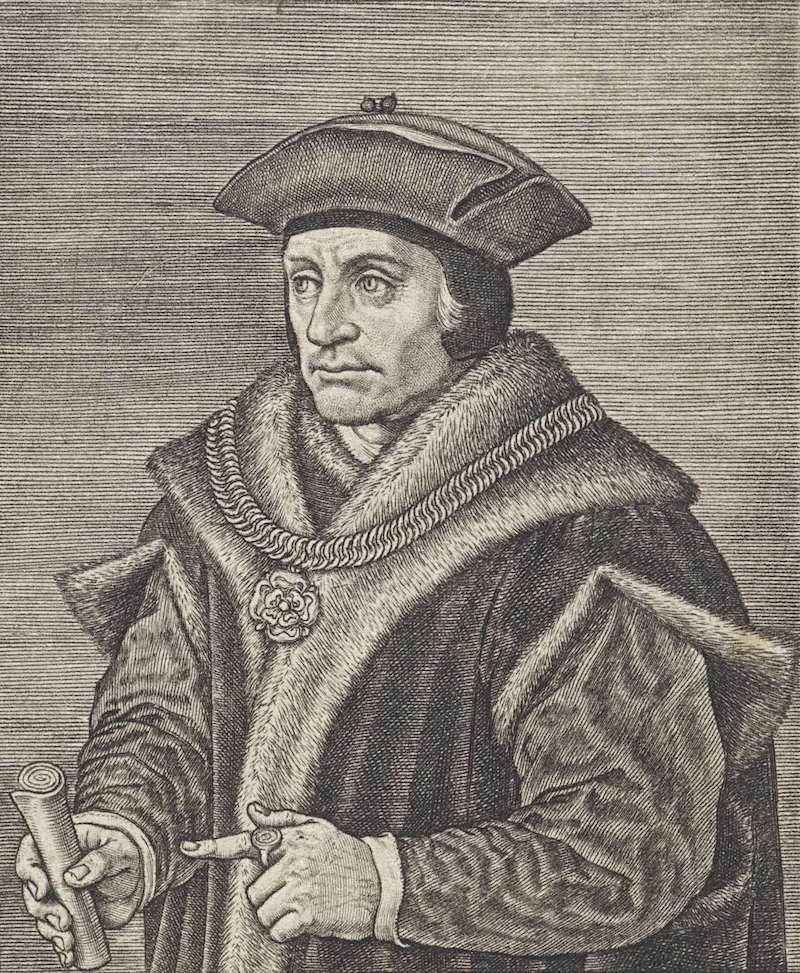The Mystery of Thomas More’s Birthplace
Walking through London’s Cheapside is a journey through history. From the Old English ceapan, meaning ‘to buy’ (and nothing to do with the Victorian associations with poverty), Cheapside’s streets are named for the items that could be bought there – Bread Street, Wood Street and Milk Street. At the end of this last street today is a sizeable plaque on the side of a very industrial-looking modern building, which reads ‘Sir Thomas More was born in a house near this site 7 February 1478’.
This is the accepted story today, but it is built on uncertain foundations. Thomas More was born decades before the first parish registers. He was born to a middling lawyer, himself the son of a baker. Property records from the 15th century are scant at best, and his contemporary biographers only state that More was born in London. In fact, the first mention of Milk Street comes more than a century and a half after More’s birth, in the biography written by his great-grandson, Cresacre More. He writes that it was ‘where the judge his father, for the most part dwelt’ and proceeds to get the year wrong, before adding some details about miracles the young More performed as an infant.
Until the end of the 20th century there was appropriate scepticism about Cresacre’s claim. In 1935 More’s first modern biographer, R.W. Chambers, hedged his bets and Richard Marius, writing 50 years later, also did not specify, writing simply that More was born in ‘the city of London’.
Not long after, however, something shifted. The plaque was put up in 1997 by the Corporation of London (now the City of London) as part of a ceremony which included a march of Catholics through the city. Recent biographies, such as by Peter Ackroyd (1999) or that which appears in the Oxford Dictionary of National Biography (2004), state categorically that More was born on Milk Street.
Milk Street in the late 15th century was a fashionable neighbourhood of the nouveau riche, mostly merchants, members of the powerful and wealthy Mercers Company. There were not many young lawyers struggling to make their mark as More’s father, John, was.
John More was the son of a baker who died when John was 16. How John went from a 16-year-old baker’s orphan to a lawyer of Lincoln’s Inn is another mystery. But he rose sufficiently to secure a marriage with the daughter of a tallow-chandler of some standing, Agnes. We know from John’s own records that the pair married at the church of St Giles-without-Cripplegate, half a mile from Milk Street, in 1474, four years before their eldest son’s birth. Both families had significant connections in the area, and Agnes’ father even appeared on property documents on Cripplegate’s Redcross Street the year of his daughter’s wedding to John More.
While relatively close to Milk Street, the area known as ‘Cripplegate Without’ was outside the London Wall and was significantly less fashionable and wealthy than Milk Street. Bordering on lawless, such neighbourhoods were frequented by thieves and sex workers, and the ditches around the walls habitually used as rubbish dumps.

There is a further clue that this is where the young Thomas More was born and grew up. It comes from one of More’s earliest writings, his unfinished History of King Richard III. Written in the 1510s but covering the year 1483, when More was seven years old, the History relies on reports from witnesses known to More to reconstruct the rise of the man he considered a usurper, Richard III. In one early scene, More places his young self in the narrative, writing that he ‘personally learned’ that Richard sought the crown ‘long ago by trustworthy report’. He clarifies that the conversation which he relates ‘was reported to my father’ by a man who overheard it himself. That conversation took place in a house on Redcross Street, in Cripplegate Without, the very street with connections to Agnes More’s father. It seems probable then that John More heard about this conversation because he lived just a few doors down.
Why, then, Milk Street? Cresacre More had not been entirely wrong; John More did live on Milk Street, or very near it, later in life. His and his son’s many connections to the Mercers (John married a string of Mercer widows), along with their respective social elevations, made the move to trendy Cheapside achievable, and there are records of John More resident there from the 1520s. The idea that Thomas More emerged from such a well-connected milieu, in the shadow of the Guildhall no less, is tempting, especially given his later connections to the Mercers, city government and local parishes.
It may have been simple error, an assumption by later biographers that Thomas More was born where his father lived out his life. There might, however, have been another motivation. Cripplegate Without maintained its unseemly associations well into the 17th century. The parish church itself, St Giles-without-Cripplegate, had also by then acquired a notably Protestant reputation. For instance, John Foxe, the Protestant propagandist who had so vilified More to Elizabethans (and beyond), had been buried there. This certainly seems to have mattered to Cresacre More and his 17th-century audience, and it might change how we think of More’s upbringing now. More’s childhood was not among the elite of London merchants, a stone’s throw from the Guildhall, but on the periphery of civilised society, bordering the moors.
Where, then, might the plaque go? Here, history presents a fascinating turn. St Giles-without-Cripplegate still stands, but many of the medieval streets around it have gone, replaced by the housing complexes of the Barbican Estate. And where Redcross Street once ran is now a garden, the largest of the Barbican gardens, known – entirely coincidentally – as Thomas More Garden.
Joanne Paul is the author of The House of Dudley (Michael Joseph, 2022) and a forthcoming biography of Thomas More.
#Mystery #Thomas #Mores #Birthplace
